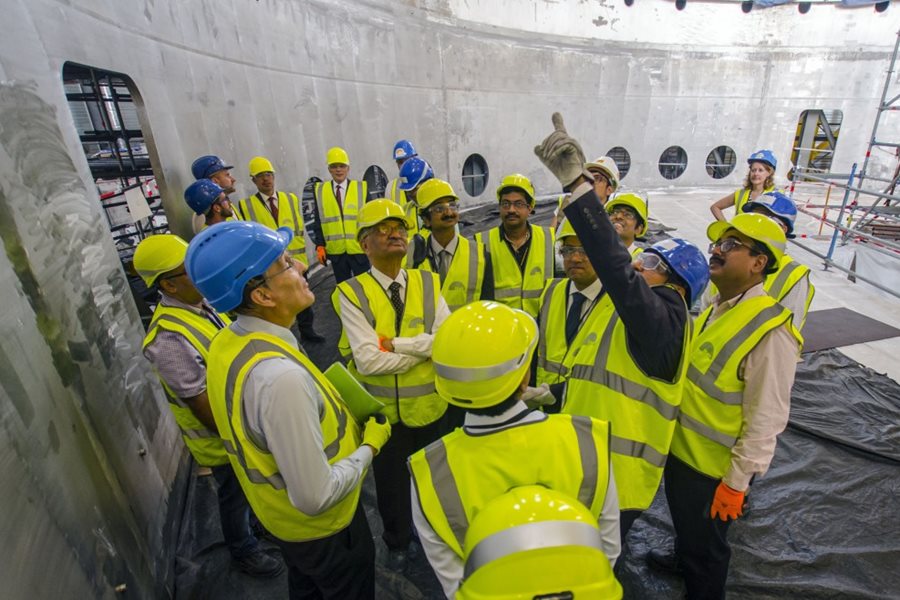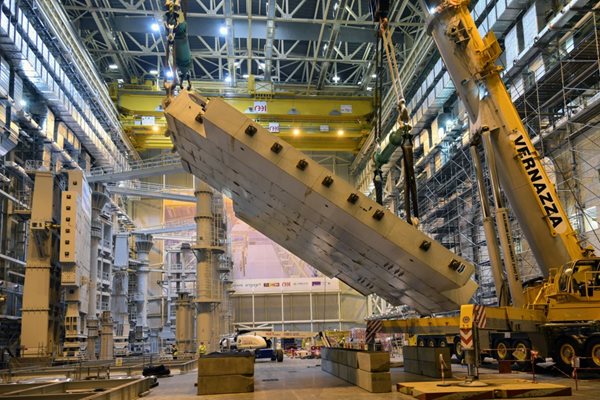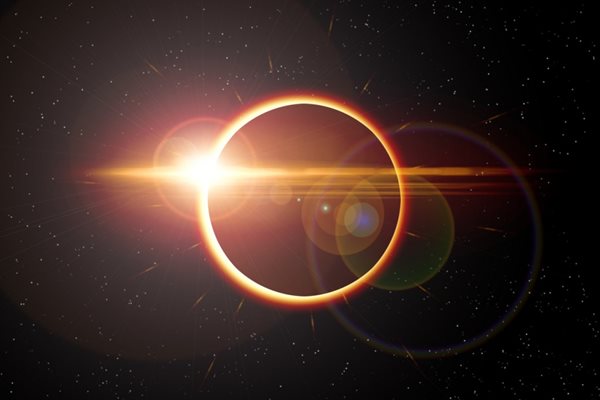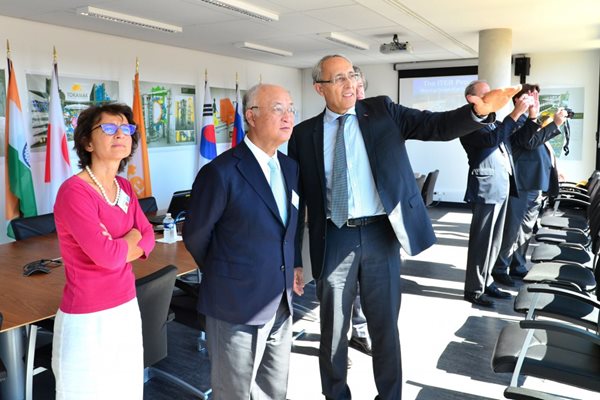
you're currently reading the news digest published from 15 Jul 2019 to 23 Jul 2019
featured4
press10
featured
A "magic moment" | Cryostat 60% complete
When a seafaring vessel is launched, naval tradition requires that a bottle be broken on its hull to invite good luck. Although the ITER cryostat will never take to the sea, it is indeed a vessel—and a most spectacular one at that. In the Cryostat Workshop, where the India-procured component is assembled and welded, ITER Director-General Bernard Bigot, India's Ambassador to France Vinay Mohan Kwatra, and the former chairman of the Atomic Energy Commission of India, Anil Kakodkar, symbolically smashed a bottle of French champagne on a large chunk of steel representing the ITER cryostat. The ceremony marked an important milestone in the fabrication of this strategic component: two sections—the base and lower cylinder—are now completed and fully accepted by the ITER Organization, the upper cylinder is being assembled and aligned prior to welding, and half a world away, in the manufacturer's facility, the last segment of the 'top lid' is being finalized. The ITER cryostat is essential to the ITER machine, providing structural support and also acting as a thermos to insulate the Tokamak's magnetic system, at cryogenic temperature, from the warmth of the outside environment. It is the largest vacuum vessel ever built—30 metres high, 30 metres in diameter, for a pump volume of 8,500 cubic metres. It is also a highly complex structure which must remain absolutely leak tight despite hundreds of 'penetrations' that give passage to thousands of feedthroughs and lines for cryogenics, water, electrical power, diagnostics systems, and more. In his address to the assembled guests, ITER Director-General Bernard Bigot retraced the 'formidable technological, industrial and human venture' that the manufacturing of such a unique object represents. 'Designing, manufacturing, delivering, assembling and welding this one-of-a kind component has proved a huge challenge for everyone involved.' And everyone involved was there, either in person or through video conference from India: the ITER cryostat team; representatives of ITER India, which is responsible for the procurement of the cryostat; industrial giant Larsen & Toubro Ltd, in charge of forging and machining the elements of the cryostat at its Hazira facility and assembling them on site; and finally the German company MAN Energy Solutions, subcontractor to Larsen & Toubro for on-site welding. The fabrication of the ITER cryostat, said Vinay Mohan Kwatra, Indian Ambassador to France, represents 'a major achievement for Indian manufacturing—whose capabilities are not always acknowledged as they should be.' The Ambassador also stressed the unique nature of ITER, a project that is 'not for the benefit of one partner or one country, but for the whole of humankind.' For Ujjwal Baruah, who recently succeeded Shishir Deshpande as Head of ITER India, the ceremony was 'a magic moment,' the culmination of a 'long march' which began in 2012 with the signature of the Cryostat Procurement Arrangement with the ITER Organization. 'Through the innumerable challenges we have faced in the manufacturing of the ITER cryostat, we have learned and grown at every step,' said Larsen & Toubro Heavy Engineering Joint General Manager Praveen Bhatt, speaking on behalf of the company's Senior Vice-President Y. S. Trivedi. This 'learning process' was also stressed by Rolf Bank, MAN Energy Solutions Head of Site for Deggendorf. The assembly and welding of the cryostat, he said, has made his company take 'big steps forward in a whole new area of expertise.' In his opening address, ITER Director-General Bernard Bigot had resituated the fabrication of the cryostat in the broader picture of the ITER Project, which he characterized as 'men and women working to the best of their ability in different parts of the world to achieve an utterly ambitious and difficult task—one that is essential for the future of our civilization.' Anil Kakodkar's keynote speech developed along the same lines. For the 'father' of the Indian nuclear program, ITER 'is our hope for the energy freedom of the world at large and for the development of the large part of humanity that is still undeveloped.' The massive international effort that ITER represents is also 'the new paradigm that humanity is desperately looking for.' One of the most respected scientific and moral figures in his country, the former chairman of the Indian Atomic Energy Commission and former Secretary to the Indian Government hailed 'the stupendous task in which you are engaged.' But as he touched on climate change, he also warned: 'Fusion must be available before the world reaches the cliff's edge.' Watch a video of the event here. For more information about the ITER cryostat, see this page on the ITER website.
Load tests | Heavyweight champion
The Assembly Hall, with its two giant tools towering 20 metres above ground, is one of the most spectacular locations on the ITER site. When a dummy load weighing as much as a fully loaded 747 is slowly upended, displaced and eventually installed into one of the tool's wings, spectacular gives way to awesome. View the gallery below and click on this time-lapse VIDEO LINK to share in the experience.
Fusion's new pioneers | How to go fast enough to make a difference
Last month in New York, the Stellar Energy Foundation and the Fusion Industry Association co-hosted an invitation-only workshop: 'Roadmap to the Fusion Energy Economy.' The Simons Foundation provided the Flatiron Institute as the venue. ITER was also invited to participate. The dialogue that resulted was unusual, in part because of the players present. Lane Genatowski, senior advisor to the Under Secretary for Science at the US Department of Energy (now Director of the Advanced Research Projects Agency ARPA-E, which promotes and funds energy innovation), delivered a keynote address. Interactive panels included representatives of multiple sectors, ranging from ARPA-E and the Princeton Plasma Physics Laboratory, to investors and philanthropists. In addition, the meeting featured private sector companies working to make fusion a commercial reality. Three themes emerged: (1) Status updates on the practical feasibility of fusion, across a range of technologies; (2) Fusion economics: R&D cost and return on investment, projected costs per kilowatt-hour, investment sources, and best uses of government funding; and (3) Communication: how best to articulate the shared goals of fusion to the public and other stakeholders across a broad range of enterprises, some of which compete with one another for limited funding. Given the range of participants, one might have expected the meeting to devolve into competitive arguments over which technology or sector deserved the most support, or which had the greatest chance of success. By contrast, discussions were mutually supportive. ITER, the giant in the room in the sense of both funding and physical size, was repeatedly praised as a point of converging research that would benefit all concerned. Much of the cross-sector and cross-project dialogue centred on how to align diverse objectives and activities to optimize the pursuit of common goals, such as public awareness, safety regulation, enabling technologies and, ultimately, commercialization. The workshop structure employed interactive panels, engaging leaders of key public and private fusion entities. Lively exchanges examined the sources and means of funding (public, private, philanthropic) needed for 'practical and timely deployment of commercial fusion.' By design, many of these discussions carried over into networking and brainstorming after the formal program. Jesse Treu is the Founder and Chairman of the Stellar Energy Foundation, a New Jersey based not-for-profit organization. Stellar is an advocacy organization focused on all aspects of the fusion energy community, worldwide, commercial, academic and government-sponsored. In addition to holding this workshop, the Foundation has helped several fusion ventures in their fund raising efforts. Treu remarked that he was struck by how rapidly the workshop grew from concept to reality. The New York city workshop grew from a breakfast session organized in Palo Alto, California by the Fusion Industry Association, an international association of private-sector fusion companies formed in December 2018 and led by Executive Director Andrew Holland. 'The success of this workshop is a milestone in fusion energy's commercial roadmap,' Treu said. 'Stellar is grateful to all who participated in this launch event. As need, opportunity, and support increase, we will continue to connect the technologies to the emerging development partnerships, and we look forward to engaging with ITER in support of our commercialization mission.' Follow these links for more information on the Stellar Energy Foundation and the Fusion Industry Association.
ITER remembers IAEA chief Yukiya Amano
The ITER Organization has learned with sadness that the three-term Director General of the International Atomic Energy Agency (IAEA), Yukiya Amano, has passed away. Director General Amano was a long-time advocate of fusion energy research, and under his leadership (2009-2019) the IAEA continued to play a central role in fostering international collaboration and coordination to help close the existing gaps in physics, technology and regulation and move forward in developing the peaceful use of fusion energy. On a visit to the ITER site in 2012, Director General Amano had these words for the ITER Newsline: 'My hope is that ITER will open the door to fusion power and provide the ITER Members with the technology to design and build the first generation of fusion power stations. The challenge is huge, but I have faith in the ingenuity of human beings and the ability of our scientists and engineers to overcome even the most daunting technological hurdles.' Director General Amano gave a keynote speech at the third Monaco ITER International Fusion Days (MIIFED) in 2013 and returned to ITER Headquarters in 2016 to discuss the possibilities for expanding cooperation between the two international organizations. These efforts resulted in the IAEA-ITER Practical Arrangements that were concluded last month. Although not present for the signature, IAEA Director General Yukiya Amano sent a statement noting the importance of the new arrangements. 'The challenge to achieve the goal of fusion power production can only be met through concerted international efforts. ITER's impressive work plays a central role in this field. We look forward to our intensified collaboration.' ITER Director-General Bernard Bigot said he was saddened by the news. 'Amano-san was a long-time personal friend and a strong, coherent voice for the promotion of nuclear power and hydrogen fusion power. He was also a true friend of ITER—not only because the IAEA is the Depository of the ITER Agreement, but also because of his personal interest and commitment. After decades of work as a champion of clean energy, he deserved a full and rich retirement, and I find it tragic to hear of his untimely passing.' Read the statement from the IAEA here.



